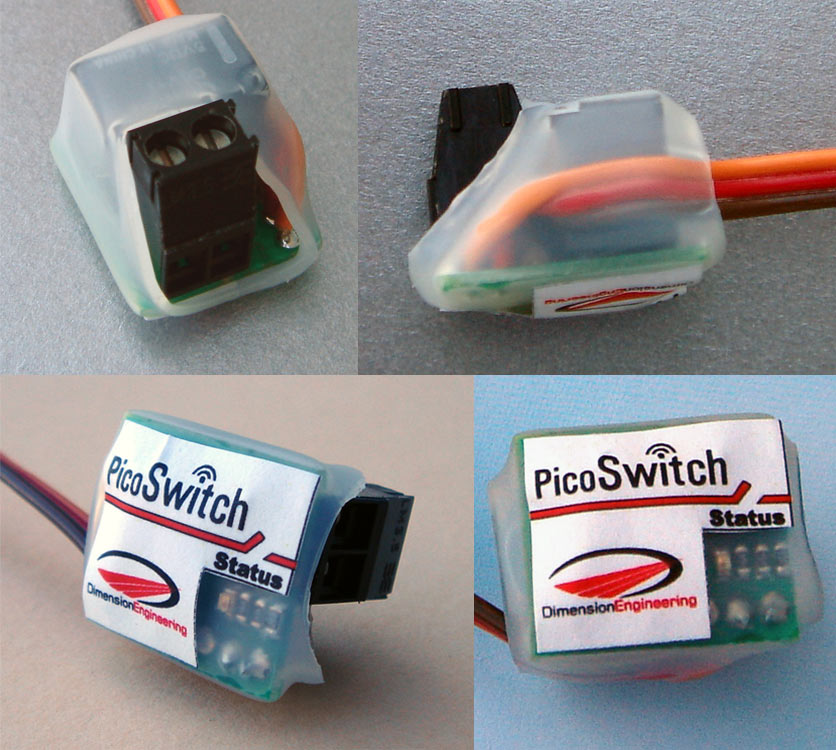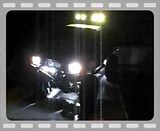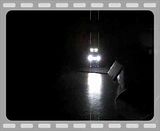| |||||||
Loading
 |
| | LinkBack | Thread Tools | Display Modes |
| |||||||
 |
| | LinkBack | Thread Tools | Display Modes |
| | #1 |
| Dirt Addict  Join Date: Jan 2004 Location: Stumblin' thru the parking lot of an invisible 7-Eleven
Posts: 1,053
|
When I started building up a scale rig I knew one thing it had to have was some lighting. I wanted to add some running/headlights and some rock lights, and I wanted to operate them from a standard 3-channel pistol radio. With steering and throttle taking two channels, that left me one channel for lighting. After a little searching I found a product from the South African company Firmtronics that could help with the lighting task. Basically, they offer a small module that plugs into your receivers third channel port and provides switch control for two loads from a single radio channel. Their small module is capable of switching up to 2.5 amps per switch and the state of each of the two switches is determined by the stick/lever/switch position on your radio. This works great for two sets of lights you may want to control from a single channel. The module has two sets of pins that mate to standard 3-pin servo connectors to wire up whatever you choose to connect to. One pin on each output provides positive voltage and a second wire switches your load to ground upon command. For you tech heads, Firmtronics starts with an Atmel Tiny 15L 8-pin SOIC 8-bit CMOS micro-controller. To that, they add some outboard passive and active components surface mounted to a small PC board and shrink-wrap it to make a compact package with about a 6 inch servo lead. I tried the module on my 3-channel radio with a potentiometer on channel 3. Both switches were off at the lowest dial setting. As the dial was moved to about the 1/3 point, the first switch turned on. At about the 2/3 point, the second switch came on and the first switch was off. At a setting near full upper limit, both switches were on. The module could be used with this setup or with a set of resistors in the transmitter that set the servo settings based on a toggle switch on the radio. In the U.S., I found the Firmtronics RCSwitch available from the Robot Market place (www.robotmarketplace.com) for about $15 plus shipping. More details and specs can be found here as well. If you’re looking for a way to add an additional switched output to your radio gear, this just might do the trick. |
| |  |
| Sponsored Links | |
| | #2 |
| owner, Holmes Hobbies LLC  Join Date: Nov 2004 Location: Volt up! Gear down!
Posts: 20,290
|
Nice find! That would make some interesting lighting possibilities, like reverse lights or brake lights. Maybe even turn signals of some sort.
|
| |  |
| | #3 |
| PapaGriz Yo  Join Date: Apr 2004 Location: In the garage building the wife a crawler
Posts: 13,137
|
That is super cool! Nice find Jay.  Lots of cool stuff on that site. Lots of cool stuff on that site.I wonder if I can get the electrical engineers at work to design me something that can handle about 50 amps........hmmmmm....... |
| |  |
| | #4 |
| On the lookout for Rocks  Join Date: Mar 2006 Location: Monroe, Louisiana
Posts: 3,711
|
Here is another one that I have found. I haven't tried one out yet. http://www.dimensionengineering.com/PicoSwitch.htm  Product Description PicoSwitch is a relay switch that you toggle via hobby radio control gear. You can use PicoSwitch to quickly and easily control anything from a digital camera shutter to an electric squirt gun to home lighting and more. You can activate applications with voltage levels as high as 125VAC without having to know anything about microcontroller logic levels or transistors because the relay offers full electrical isolation from your receiver electronics. PicoSwitch plugs into a standard hobby radio control receiver as easily as a servo does. You connect the load that you want to toggle using PicoSwitch's wear resistant screw terminals. Depending on the channel you use, you will then be able to control the relay by moving your radio's control stick up or down, left or right, or another method you desire. Picoswitch has a status LED on the bottom. The LED will light up when the relay switch is on, and vice versa. It will also tell you if your radio link is too weak by flashing repeatedly. The relay is a single pole single throw switch. Its typical lifetime is 100,000 to 1,000,000 switching cycles, depending on how heavy a load you are using. The relay is normally open when unpowered. PicoSwitch does not supply power at the screw terminals. PicoSwitch should not be used to switch inductive loads like motors or solenoids without an antiparallel diode. Need more power? Try BattleSwitch. Specifications: Max relay voltage: 60VDC, 125VAC Max relay current: 1A @ 24VDC, 0.5A @ 125VAC (60W lightbulb) Relay resistance: 100 mΩ max 3.5V to 5.5V operating voltage (on servo pigtail) 30mA typical draw from receiver Note: PicoSwitch has a maximum voltage rating of 125VAC, meaking it unsuitable for toggling 220VAC applications. Diagrams: PicoSwitch example diagram.jpg Dimensions: 0.75" x 0.62" x 0.62" 20mm x 16mm x 16mm 12 inch servo pigtail Applications: Control of lighting systems on RC planes, boats, cars. Control of digital cameras in aerial photography. Control of auxiliary weapons in RC combat tournaments. Control of low power home lighting systems. Control of nearly any low powered application that can be toggled with a switch. Example projects: Using PicoSwitch to control christmas lights Using PicoSwitch to control a digital camera Using PicoSwitch to control sound effects Skulltronix uses PicoSwitch to turn off servo power between animation routines timetocreatetoys uses PicoSwitch in prebuilt aerial photography systems |
| |  |
| | #5 | |
| Rock Crawler  Join Date: Jan 2008 Location: Jonesboro, Arkansas
Posts: 879
| Quote:
| |
| |  |
| | #6 |
| I wanna be Dave Join Date: Nov 2005 Location: Here
Posts: 7,317
|
Tamiya makes a set up that works great and gives you lots of flexibility. The TLU-02 is the control unit that gives you 16 profiles including turn signals, reverse lights, ect. The TLU-01 can be used separately but you will not have the profiles. The combination of the two can give you up to 16 pair of lights. Here is mine right now...   |
| |  |
| | #7 | |
| Rock Crawler Join Date: Nov 2007 Location: Dayton, Ohio
Posts: 506
| Quote:
Wow that is sweet!!! | |
| |  |
| | #8 |
| I wanna be Dave Join Date: Jul 2006 Location: Moscow Mills MO
Posts: 2,204
|
Nice finds  I just remove the motor from a cheapo servo and wire a plug to the board for the led's. |
| |  |
| | #9 |
| Dirt Addict  Join Date: Jan 2004 Location: Stumblin' thru the parking lot of an invisible 7-Eleven
Posts: 1,053
| |
| |  |
| | #10 |
| Pebble Pounder Join Date: Dec 2007 Location: UK
Posts: 146
| |
| |  |
| | #11 | |
| Rock Crawler Join Date: Jul 2007 Location: Rectalville
Posts: 889
| Quote:
The tamiya units are cool, but they're like $350!!!! I could get a whole 'nother crawler! | |
| |  |
| | #12 | |
| RCC Addict Join Date: Sep 2005 Location: Beaver County, PA
Posts: 1,366
| Quote:
He isn't using the MFC-02, he is using the TLU's. Check his link for prices. I had Vic at RCLighting help me out with a transmitter opperated light set for my Hilux: http://www.youtube.com/watch?v=RAGKTakDRsI | |
| |  |
| | #13 |
| I wanna be Dave Join Date: Jul 2006 Location: Moscow Mills MO
Posts: 2,204
| not really. I have a multiplex radio, which has flash function on the servos if you want. You can make one board turn on two sets of lights at different times if you want to(for signals). when you push the switch one way, it activates the right signal, left it turns on the left, center is no signals. I will show pics/vid of that later. here is just lights with two different boards running them on just flash. you can also proportianally turn on the lights(dim/bright) too.  |
| |  |
| | #14 |
| Tire&Foam Extraordinaire  Join Date: Jun 2007 Location: C.I. Compound, Tyler, Texas
Posts: 5,601
|
Nice find. I see lights in my scalers future. Plus with a DX6 I have plenty of channels to choose from |
| |  |
| | #15 |
| Quarry Creeper Join Date: Nov 2007 Location: Funky Town
Posts: 211
|
Here are the ones I use. They offer different amp ratings. Most of them are not reversable current so you can only turn lights on/off but it wont reverse the winch motor.  http://www.robotmarketplace.com/prod...nterfaces.html They also use a seperate switched power source, its not powered from the Rec.  |
| |  |
| | #16 |
| RCC Addict Join Date: Mar 2007 Location: St. Louis (High Ridge)
Posts: 1,279
|
so my $8 mini servo and $2 toggle switch are obsolete now?
|
| |  |
| | #17 |
| I wanna be Dave Join Date: Jul 2006 Location: Moscow Mills MO
Posts: 2,204
| |
| |  |
| | #18 |
| Dirt Addict  Join Date: Jan 2004 Location: Stumblin' thru the parking lot of an invisible 7-Eleven
Posts: 1,053
| |
| |  |
| | #19 |
| On the lookout for Rocks  Join Date: Mar 2006 Location: Monroe, Louisiana
Posts: 3,711
| |
| |  |
| | #20 | |
| On the lookout for Rocks  Join Date: Mar 2006 Location: Monroe, Louisiana
Posts: 3,711
| Quote:
| |
| |  |
 |
| |